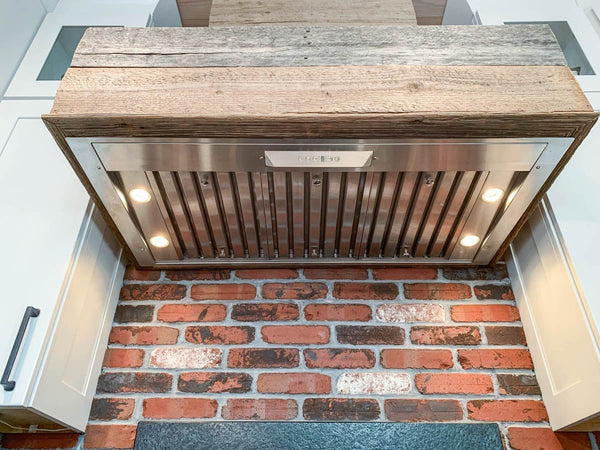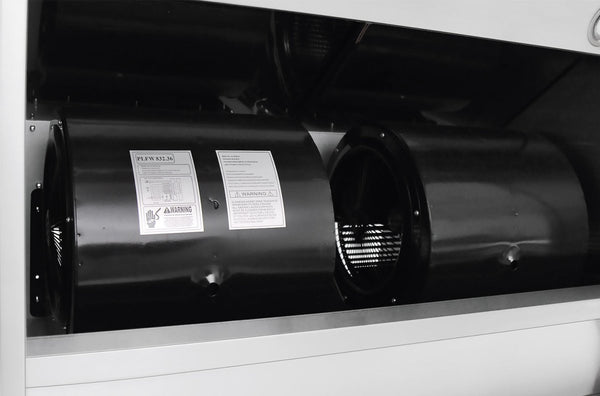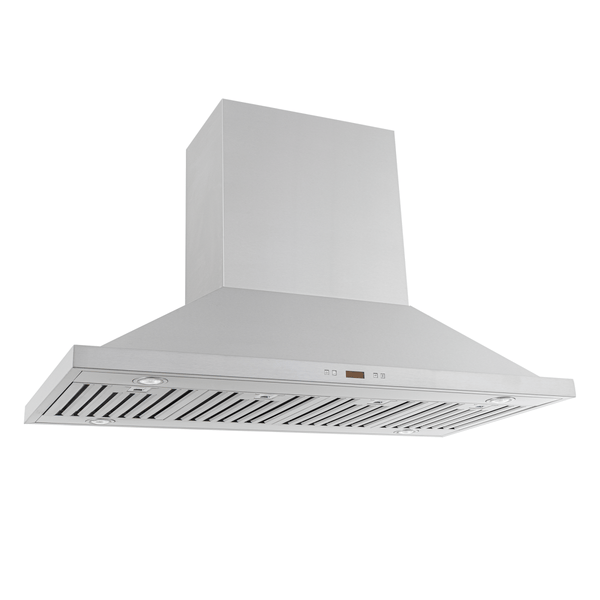Table of Contents
A well-maintained kitchen is the heart of a home. It's where meals are prepared and memories are made. But what keeps this heart healthy?
The answer lies in the range hood—an often overlooked but critical appliance in maintaining a clean and healthy kitchen environment.
Whether you're a contractor evaluating ventilation systems or a homeowner trying to avoid a smoky kitchen, this guide walks you through how to clean a range hood filter, how to clean grease from the vent hood, and general kitchen ventilation cleaning best practices.
Why Range Hood Maintenance Matters
- 🫁 Improve Air Quality – by filtering smoke, grease, and cooking odors
- 🔥 Enhance Fire Safety – by preventing grease buildup in the hood and duct
- ⚡ Boost Energy Efficiency – a clean hood runs more smoothly
- 🛠️ Extend Appliance Lifespan – with fewer costly repairs over time
To keep your range hood in top condition, consider the following maintenance practices:
- Clean filters regularly to prevent blockages.
- Inspect the ductwork for obstructions.
- Use appropriate cleaning products for surfaces.
- Check and tighten screws periodically.
- Replace worn-out parts as needed.
Understanding these maintenance tips can save you time and money in the long run. By incorporating them into your regular cleaning routine, you ensure that your range hood functions well.
Maintenance Schedule at a Glance
| Component | Maintenance Task | Frequency |
|---|---|---|
| Grease Filters | Clean thoroughly | Every 1–2 months |
| Charcoal Filters | Replace | Every 3–6 months or 30 hours |
| Hood Exterior | Wipe down | Weekly |
| Fan Blades | Clean | Every 3 months |
| Ductwork | Inspect for blockages | Every 6 months |
| Complete System | Professional inspection | Annually |

Kitchen Ventilation Cleaning: A Full-System Approach
Kitchen ventilation goes beyond just the hood. Here’s how to keep the whole system running efficiently.
Vent Hood Duct Cleaning
Why it matters: Over time, grease and debris can build up inside the ductwork, restricting airflow and becoming a fire hazard.
Signs your duct needs cleaning:
- Reduced suction or airflow
- Lingering odors
- Grease stains near vent exits
- Rattling or unusual sounds
How to Clean Range Hood Ducts
- Turn off and unplug the hood
- Inspect the duct opening
- Use a flexible duct brush
- Vacuum out loose debris
- Wipe down accessible areas
For hard-to-reach or long ducts, consider hiring a professional duct cleaning service once a year. They use tools like inspection cameras and high-power vacuums to ensure a thorough clean.
Ducted vs. Ductless Range Hoods: Maintenance Differences
Ducted Range Hoods
- Function: Extract air and vent it outside through ductwork
- Advantages: Most effective at removing contaminants completely from the home
-
Special Maintenance Needs:
- Regular duct inspection for blockages and leaks
- Checking exterior vent caps for debris or pest infiltration
- Ensuring dampers operate freely
- Inspecting for moisture accumulation in ducts during seasonal changes
Ductless (Recirculating) Range Hoods
- Function: Filter air and recirculate it back into the kitchen
- Advantages: Can be installed anywhere, no ductwork required
-
Special Maintenance Needs:
- More frequent filter replacement (both grease and charcoal)
- Monitoring for decreased suction power
- Ensuring recirculation vents remain unobstructed
- More thorough interior cleaning as all contaminants remain in the system
Maintenance Guide
1. Filter Maintenance
Grease Filters:
- Soak in hot, soapy water for 15+ minutes
- Scrub with a soft brush
- Rinse thoroughly and air dry completely before reinstalling
Charcoal Filters:
- Cannot be cleaned – must be replaced
- Follow manufacturer's replacement timeline (typically 3-6 months)
- Ensure new filters fit securely
2. Hood and Ductwork Care
Ductwork:
- Check for blockages and obstructions
- Ensure seals are tight to prevent leaks
- Look for damage or loose connections
- Consider professional inspection for complex systems
Hood Exterior:
- Use non-abrasive cleaners to avoid scratches
- Wipe down regularly to prevent grease buildup
- Pay special attention to undersides where grease accumulates
3. Fan Maintenance
- Access fan blades by removing the cover
- Clean each blade with soapy water
- Remove accumulated dust and grease
- Check for loose components or unusual noises
Troubleshooting Common Range Hood Issues
| Problem | Possible Causes | DIY Solutions | When to Call Professional |
|---|---|---|---|
| Poor Suction | Clogged filters, blocked ducts | Clean filters, check vent caps | Still poor after filter cleaning |
| Excessive Noise | Loose parts, damaged motor | Tighten parts, clean blades | Grinding or humming sounds |
| Vibration | Loose mount or fan imbalance | Tighten mount, balance fan | If vibration affects structure |
| Unresponsive Controls | Power or board issue | Check power, clean controls | Still unresponsive after reset |
| Lights Out | Burnt bulbs, wiring issue | Replace bulbs | If bulbs fail repeatedly |
| Grease Drips | Dirty filters, duct leak | Clean filters, reseal ducts | Leaking from internal joints |
When to Call a Professional for Maintenance or Repair
While many maintenance tasks are do-it-yourself, some situations call for professional expertise. If you've checked all basic troubleshooting steps and the range hood still malfunctions, it's wise to seek expert help.
Professionals can tackle electrical issues, complex repairs, and installations. They ensure safety and efficiency, preserving the longevity of your range hood while minimizing potential hazards.

Enhancing Range Hood Longevity and Performance
Implementing a routine maintenance checklist ensures all aspects of your range hood are addressed consistently. This approach reduces the risk of unexpected issues.
- Check and clean filters regularly.
- Wipe down the exterior weekly to prevent grease buildup.
- Inspect the ductwork for obstructions.
Besides DIY maintenance, keep an eye on the vent hood's performance. Notice any reduction in suction? This may indicate a need for deeper cleaning or servicing.
Consider upgrading components like filters or even the hood itself when necessary. This approach ensures you're utilizing the most efficient technologies available.
Regular Inspections and the Role of Professional Services
Scheduled professional inspections can significantly boost the performance and lifespan of your range hood. Experts can spot and address issues before they escalate.
Professional Inspection Checklist
What Professionals Should Examine:
- Complete disassembly and internal inspection
- Motor amperage draw testing
- Bearing lubrication or replacement
- Electrical component safety testing
- Complete ductwork inspection with cameras
- Damper functionality and sealing
- Proper hood balance and mounting security
- Verification of adequate ventilation rates for kitchen size
The Impact of Cooking Habits on Range Hood Maintenance
Your cooking habits greatly influence how often your range hood needs attention. Heavy cooking, especially frying, can lead to rapid grease accumulation.
If you're an avid cook, step up the frequency of your maintenance routine. Ensure filters are cleaned and checked more often to keep up with higher usage.
On the other hand, if you cook lightly or infrequently, adjust your schedule accordingly but avoid neglect. Even light cooking can eventually lead to buildup over time. By tailoring your maintenance approach to suit your cooking habits, you ensure your range hood remains effective and efficient.
Conclusion: The Benefits of a Well-Maintained Range Hood
-
A well-maintained range hood is an investment in:
- Health: Better air quality for respiratory wellness
- Safety: Reduced fire risk and improved visibility while cooking
- Property Value: Protected kitchen surfaces and extended appliance life
- Energy Efficiency: Optimal performance with minimal power consumption
- Cooking Enjoyment: Odor-free, comfortable cooking environment
By following this comprehensive maintenance guide, your range hood will provide years of reliable service while protecting your kitchen and home. Remember that consistent basic maintenance prevents costly repairs and replacement, making the small time investment in regular care well worth the effort.












